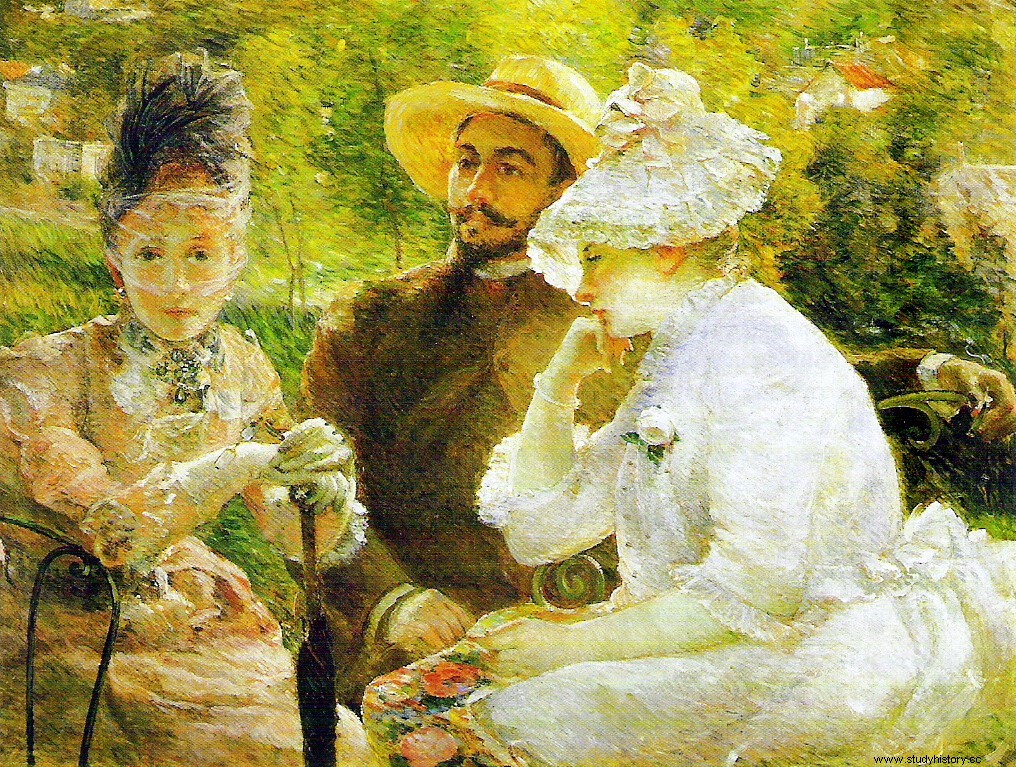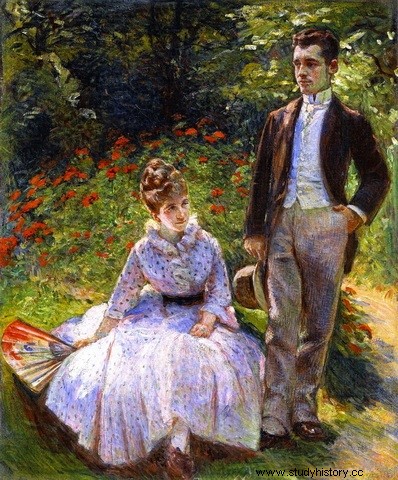French painter, Marie Bracquemond (1840 – 1916) is one of the great ladies of Impressionism along with Berthe Morisot and Mary Cassatt. Long overshadowed by her husband, she is beginning to gain the recognition she deserves.
Learning
 Marie Anne Caroline Quivoron was born on December 1, 1840 in Landunvez, near Brest in Brittany. His father, a sailor, died shortly after his birth and his mother, Aline Hyacinthe Marie Pasquiou, quickly remarried to Émile Langlois. The couple lead a nomadic existence, living with their two daughters, Marie and Louise born in 1849, in Brittany, the Jura, Switzerland, Limousin, before settling in Etampes.
Marie Anne Caroline Quivoron was born on December 1, 1840 in Landunvez, near Brest in Brittany. His father, a sailor, died shortly after his birth and his mother, Aline Hyacinthe Marie Pasquiou, quickly remarried to Émile Langlois. The couple lead a nomadic existence, living with their two daughters, Marie and Louise born in 1849, in Brittany, the Jura, Switzerland, Limousin, before settling in Etampes.
As a teenager, Marie took painting lessons from Auguste Vassort, a retired painter who passed on his art to the young women of the village. Talented and persevering, she progresses quickly. As early as 1857, she submitted a painting of her mother, sister, and teacher to the Paris Salon de peinture et de sculpture, and her work was accepted. She then met the painter Jean-Auguste-Dominique Ingres and continued her apprenticeship with him. Of him, Marie would write that his severity frightened him. "He doubted the courage and perseverance of women in the field of painting, and only attributed to them the painting of flowers, fruits, still lifes, portraits and genre scenes. She ended up leaving Ingres' studio to work on her own, regularly participating in the Paris Salon and being commissioned by the general director of French museums to make copies at the Louvre.
The porcelain painter
 It was when Marie was working at the Louvre that she met the painter Auguste Joseph Bracquemond, known as Félix Bracquemond. The two fell in love and married in 1869, despite the opposition of Marie's mother. The following year, their only son, Pierre, was born. The birth puts Marie's already delicate health in jeopardy. From the memoirs written by Marie and her son, the marriage seems to have been difficult. Félix rejects his wife's criticisms but criticizes his work extensively, and refuses to show his paintings to visitors. friction between spouses is frequent.
It was when Marie was working at the Louvre that she met the painter Auguste Joseph Bracquemond, known as Félix Bracquemond. The two fell in love and married in 1869, despite the opposition of Marie's mother. The following year, their only son, Pierre, was born. The birth puts Marie's already delicate health in jeopardy. From the memoirs written by Marie and her son, the marriage seems to have been difficult. Félix rejects his wife's criticisms but criticizes his work extensively, and refuses to show his paintings to visitors. friction between spouses is frequent.
Félix having become artistic director of the Parisian workshop of the firm Charles Haviland, a porcelain manufacturer from Limoges, Marie works alongside him and produces table services as well as large earthenware panels. In 1878, she presented at the Universal Exhibition in Paris a large ceramic tile panel, three meters high and seven meters wide, representing the muses of the arts. The painter Edgar Degas complimented her on it and, in 1879, Marie exhibited a ceramic dish and the preparatory cartoons for her earthenware panel in an Impressionist exhibition.
Friend of the Impressionists
Félix and Marie Bracquemond frequent many painters, including Alfred Stevens, Claude Monet, Edgar Degas, Paul Gauguin, Édouard Manet and Alfred Sisley. While her art remained marked for a long time by her years spent at Ingres' studio, Marie broke away from his influence and her style gradually changed. Inspired in particular by Alfred Stevens, Claude Monet and Edgar Degas, she intensified her colors, worked on clarity and variations of tones, and began to paint outdoors, particularly in her garden in Sèvres. She exhibited paintings at the Impressionist exhibitions of 1879, 1880 and 1886. In 1890, worn down by the tensions within her marriage and discouraged by the incessant criticism and her husband's lack of interest in her work, Marie stopped painting. . She will only produce a few private paintings, despite everything endeavoring to defend Impressionism.
Marie Bracquemond died in Paris on January 17, 1916, two years after her husband.



